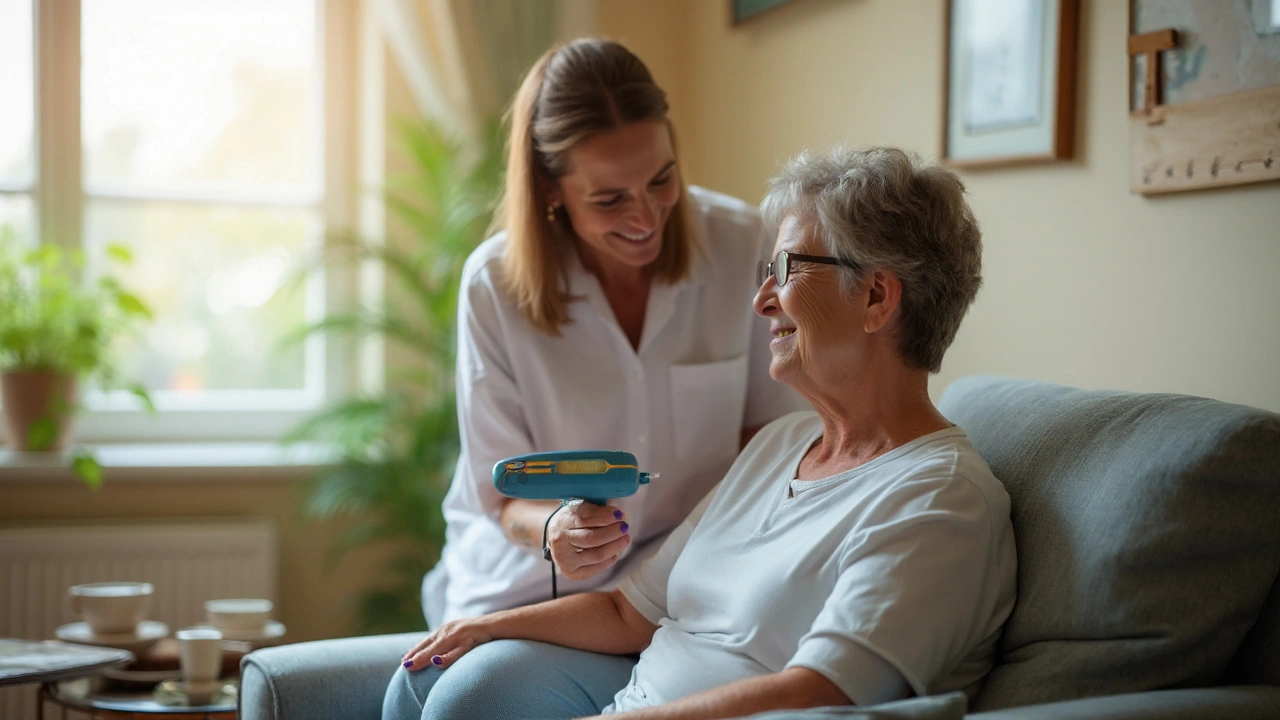
Occupational Therapy is a rehabilitative profession that helps individuals regain independence in daily activities despite physical, cognitive, or emotional challenges. When the challenge is a breathing disorder, OT steps in with a toolbox of techniques that go beyond the traditional medical model.
What Counts as a Breathing Disorder?
Breathing disorders are conditions that impair the body’s ability to inhale oxygen or exhale carbon dioxide efficiently. The most common culprits are COPD (chronic obstructive pulmonary disease) and asthma, but the umbrella also covers restrictive lung disease, bronchiectasis, and even post‑COVID‑19 sequelae. In NewZealand, COPD affects roughly 250,000 adults, while asthma touches about 350,000 - numbers that translate into a massive demand for functional support.
Why Occupational Therapy Matters for the Lungs
Most people think of OT as the hand‑crafts‑and‑daily‑living specialist, yet the profession’s core aim is to optimise activities of daily living (ADL). When breathing is compromised, simple ADLs-like dressing, cooking, or even walking to the mailbox-become energy‑draining tasks. OT bridges that gap by:
- Teaching airway‑clearance techniques that reduce coughing episodes.
- Training the diaphragm and accessory muscles to improve ventilation efficiency.
- Adapting the home environment so that energy‑expensive movements are minimised.
- Co‑ordinating with an interdisciplinary team (physiotherapists, pulmonologists, speech‑language pathologists) to align goals.
Core OT Interventions for Breathing Disorders
Below is a snapshot of the most frequently applied strategies. Each one pairs a therapeutic principle with a concrete activity.
- Diaphragmatic Breathing Exercise: Clients lie on their back with a light weight on the abdomen, inhaling slowly through the nose to raise the weight. Over weeks, the move translates to better breath control while dressing or climbing stairs.
- Incentive Spirometry: Using an incentive spirometer encourages deep inhalations that keep alveoli open. OT integrates the device into routine tasks-e.g., a quick session after brushing teeth.
- Airway Clearance Techniques: Techniques like huff coughing, active cycle of breathing, or using a handheld oscillatory device are taught in the context of preparing meals, so the client can clear secretions without interrupting daily flow.
- Energy Conservation Training: OT analyses a client’s schedule, re‑orders tasks (e.g., sitting while chopping vegetables), and introduces adaptive equipment such as a lightweight kitchen cart.
- Positioning and Postural Support: Proper alignment reduces work of breathing. OT may recommend a recliner with lumbar support for nighttime reading, which also eases diaphragmatic excursion.
- Patient Education: Insight into trigger avoidance (dust, cold air) and medication timing empowers clients to plan activities around peak lung function.
Case Snapshot: From Fatigue to Freedom
Emma, a 62‑year‑old Auckland retiree with moderate COPD, struggled to wash dishes without gasping. An OT assessment revealed three barriers: poor diaphragmatic engagement, inefficient kitchen layout, and lack of pacing.
- She learned diaphragmatic breathing during a 10‑minute daily session, tracking progress with a portable spirometer.
- Her kitchen was reorganised-items she used most were placed within arm’s reach, and a pull‑out countertop reduced the need to bend.
- Emma adopted a ‘two‑minute rule’: work for two minutes, rest for 30 seconds, then resume. After six weeks, her post‑dishwashing fatigue score dropped from 8/10 to 3/10, and her six‑minute walk distance improved by 45 metres.
This example illustrates how OT’s focus on functional context turns clinical gains into real‑world independence.

Comparing OT With Other Rehab Approaches
| Aspect | Occupational Therapy | Physical Therapy |
|---|---|---|
| Primary Goal | Enable ADL performance with optimal breathing | Improve cardiovascular endurance and muscle strength |
| Key Techniques | Diaphragmatic breathing, energy‑conservation, equipment adaptation | Aerobic conditioning, resistance training, inspiratory muscle training |
| Typical Session Length | 30-45 minutes, often embedded in daily routines | 45-60 minutes, focused on exercise sets |
| Outcome Measures | ADL independence scores, fatigue rating, spirometry | Peak VO2, 6‑minute walk distance, muscle strength |
| Client Profile | Individuals whose daily tasks are limited by breathlessness | Clients aiming for higher endurance or post‑surgical recovery |
Both professions complement each other, but OT uniquely ties breathing mechanics to the specifics of daily life-something that directly translates to a better quality of life.
Related Concepts Worth Exploring
Understanding OT’s role opens doors to several adjacent topics:
- Pulmonary Rehabilitation - a broader programme that often includes OT, PT, nutrition, and counseling.
- Assistive Respiratory Devices - from portable oxygen concentrators to handheld PEP devices.
- Patient‑Centred Goal Setting - collaborative process that drives all OT interventions.
- Behavioural Change Models - frameworks like the Transtheoretical Model that help embed breathing exercises into daily habit loops.
Practical Takeaways for Clients and Caregivers
- Ask your OT for a home‑assessment; small layout tweaks can cut breathlessness by up to 20%.
- Integrate breathing drills into routine moments-while waiting for the kettle or during TV commercials.
- Track progress with simple tools: a peak flow meter, a fatigue diary, or a step counter.
- Collaborate with the whole health team; share OT goals so physiotherapists and doctors can reinforce them.
- Don’t overlook the psychosocial side-stress can tighten chest muscles, making breathing exercises less effective.
Future Directions: OT in the Age of Tele‑Health
Since 2021, NewZealand’s health system has expanded tele‑rehab services. OT can now deliver virtual breathing‑coach sessions, video‑guided diaphragmatic drills, and remote home‑environment audits using 360° camera tours. Early data from a 2024 pilot show a 15% increase in adherence to daily breathing exercises when OT support is delivered via video compared with phone‑only check‑ins.

Frequently Asked Questions
What does an occupational therapist do for someone with COPD?
The therapist assesses how breathlessness limits daily tasks, teaches breathing techniques, recommends equipment (like an incentive spirometer), and redesigns the home environment to conserve energy while performing essential activities.
Can OT help children with asthma?
Yes. Pediatric OT focuses on play‑based breathing exercises, asthma‑trigger education, and strategies to keep children active without excessive wheeze, ensuring school participation stays on track.
How is progress measured in occupational therapy for breathing disorders?
Progress is tracked by objective data (spirometry, peak flow), functional scores (Barthel Index, Canadian Occupational Performance Measure), and subjective feedback (fatigue rating, quality‑of‑life questionnaires).
Do I need a prescription to see an occupational therapist for breathing issues?
In most of NewZealand, a referral from a GP or pulmonary specialist is required for publicly funded OT services, though private practitioners may accept self‑referrals.
What equipment might an OT recommend for home use?
Common items include an incentive spirometer, a portable humidifier, lightweight kitchen tools, and adaptive seating that promotes upright posture for easier breathing.
Is tele‑occupational therapy as effective as in‑person sessions?
Recent studies in 2023‑2024 show comparable adherence rates and functional outcomes when OT coaching is delivered via video, provided the client has a safe environment for supervised exercises.





Comments (12)
Jackie Berry
Wow, this deep dive into occupational therapy for breathing disorders really opened my eyes about how interdisciplinary rehab can get. I love how the article starts by breaking down what a breathing disorder actually means, because many people lump everything under asthma or COPD without realizing the breadth. The bit about OT focusing on daily activities makes perfect sense; after all, we spend most of our day doing chores, not just exercising on a treadmill. Diaphragmatic breathing, incentive spirometry, and airway clearance techniques are all things I’ve heard of, but seeing them tied to real‑world tasks like brushing teeth or chopping veggies is brilliant. The case of Emma from Auckland hit home – who hasn’t felt winded after a dish‑washing marathon? Her kitchen redesign and the two‑minute rule show how small environmental tweaks can transform fatigue into freedom. I also appreciate the table comparing OT and PT; it clarifies that while PT builds endurance, OT makes sure you can actually get the coffee pot without gasping. Tele‑health being used for virtual breathing‑coach sessions feels like the future, especially for folks in remote areas. The FAQ section at the end nicely wraps up common concerns, like referral requirements and equipment suggestions. Overall, the piece is packed with actionable tips, solid evidence, and a hopeful outlook for anyone dealing with chronic breathlessness.
Aly Neumeister
Interesting read, though I wish more emphasis was placed on the underlying systemic issues that make these therapies necessary; the healthcare system often overlooks the social determinants of health, which perpetuates the very problems OT tries to mitigate.
joni darmawan
Indeed, the integration of social context is crucial. When occupational therapists assess not only the physiological limitations but also the environmental and psychosocial factors, the interventions become far more sustainable. This holistic perspective aligns with the philosophical underpinnings of occupational therapy, where the person‑environment‑occupation triad is central.
Richard Gerhart
From a practical standpoint, the energy‑conservation strategies mentioned - like reorganising the kitchen and the two‑minute rule - are real game‑changers. I’ve seen patients go from being unable to finish a meal prep to confidently cooking a full dinner after a few weeks of OT coaching. The key is consistency and embedding breathing drills into those everyday moments, just like the article suggests.
Kim M
👍 Sure, tips are nice, but have you considered how a lot of the equipment recommended is actually funded by big pharma? The incentives to push spirometers and PEP devices are part of a larger agenda to keep patients dependent on proprietary tech. 🌐
Martin Gilmore
Honestly, the article is fine, but it completely ignores the cultural nuances-, you know-, that affect compliance; people from different backgrounds may not resonate with the same techniques, a point totally missed.
jana caylor
True, cultural tailoring is essential. In my experience, adapting the breathing exercises to fit familiar routines-like using a prayer chant for rhythm-boosts adherence dramatically.
Vijendra Malhotra
Exactly! And let’s not forget that many patients in rural areas lack the internet bandwidth for tele‑OT, making the ‘virtual coaching’ claim somewhat elitist.
Nilesh Barandwal
All good points, but remember-progress is measured, not just felt.
Elise Smit
Absolutely, objective metrics like spirometry and fatigue diaries are vital for tracking improvement. They also help clinicians adjust the program in real‑time, ensuring the patient stays on track.
Jeremiah Morgan
It is encouraging to see such comprehensive coverage of OT interventions, and I would like to emphasize the importance of interprofessional collaboration. When physiotherapists, pulmonologists, and occupational therapists synchronize their goals, the patient benefits from a unified care pathway, leading to more robust functional outcomes.
nina greer
Collaboration truly amplifies patient outcomes.